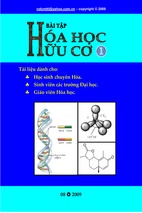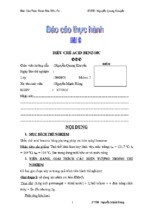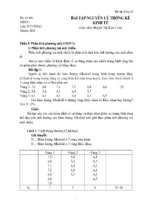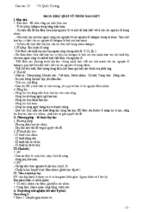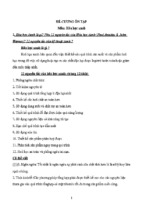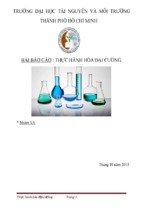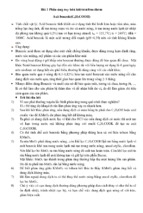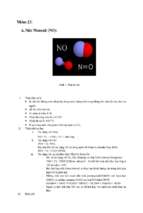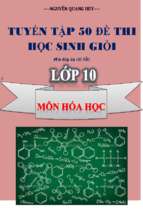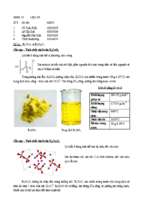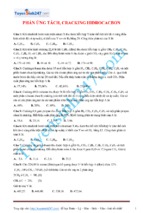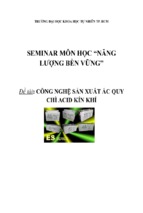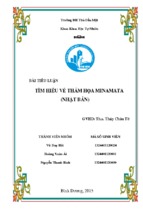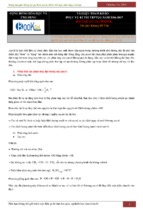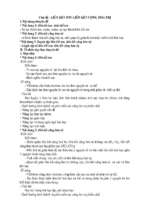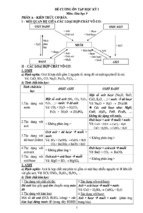Practical and Industrial
Applications
Second Edition
Analytical Chemistry
Series
Charles H. Lochmüller, Series Editor
Duke University
Quality and Reliability in Analytical Chemistry
George-Emil Bailescu, Raluca-Ioana Stefan, Hassan Y. Aboul-Enein
HPLC: Practical and Industrial Applications,
Second Edition
Joel K. Swadesh
Practical and Industrial
Applications
Second Edition
Edited by
Joel K. Swadesh, Ph.D.
CRC Press
Boca Raton London New York Washington, D.C.
Library of Congress Cataloging-in-Publication Data
HPLC: practical and industrial applications / J.K. Swadesh, editor.--2nd. ed.
p. cm. (Analytical chemistry series)
Includes bibliographical references and index.
ISBN 0-8493-0003-7 (alk. paper)
1. High performance liquid chromatography. 2. High performance liquid
chromatography--Industrial applications. I. Swadesh, Joel. II. Analytical chemistry
series (CRC Press)
QP519.9H53H694 2000
543′.0894—dc21
00-046806
CIP
This book contains information obtained from authentic and highly regarded sources. Reprinted material
is quoted with permission, and sources are indicated. A wide variety of references are listed. Reasonable
efforts have been made to publish reliable data and information, but the author and the publisher cannot
assume responsibility for the validity of all materials or for the consequences of their use.
Neither this book nor any part may be reproduced or transmitted in any form or by any means, electronic
or mechanical, including photocopying, microfilming, and recording, or by any information storage or
retrieval system, without prior permission in writing from the publisher.
All rights reserved. Authorization to photocopy items for internal or personal use, or the personal or
internal use of specific clients, may be granted by CRC Press LLC, provided that $.50 per page
photocopied is paid directly to Copyright Clearance Center, 222 Rosewood Drive, Danvers, MA 01923
USA. The fee code for users of the Transactional Reporting Service is ISBN 0-8493-00037/00/$0.00+$.50. The fee is subject to change without notice. For organizations that have been granted
a photocopy license by the CCC, a separate system of payment has been arranged.
The consent of CRC Press LLC does not extend to copying for general distribution, for promotion, for
creating new works, or for resale. Specific permission must be obtained in writing from CRC Press LLC
for such copying.
Direct all inquiries to CRC Press LLC, 2000 N.W. Corporate Blvd., Boca Raton, Florida 33431.
Trademark Notice: Product or corporate names may be trademarks or registered trademarks, and are
used only for identification and explanation, without intent to infringe.
© 2001 by CRC Press LLC
No claim to original U.S. Government works
International Standard Book Number 0-8493-0003-7
Library of Congress Card Number 00-046806
Printed in the United States of America 3 4 5 6 7 8 9 0
Printed on acid-free paper
Preface to the second edition
It is a distinct pleasure to be able to look back on a first edition and find it
to have been complete, timely, and prescient. In particular, the decision to
include capillary electrophoretic techniques in a book on chromatography
was in retrospect a good one, fully justified by the emergence of combined
electrophoresis-chromatography, or electrochromatography as one of the
brightest areas in the field of separations. On the other hand, recent stellar
achievements in interfacing chromatography and mass spectroscopy merited
the inclusion of a new section in the second edition. Miniaturization, automation and massive parallelism continue to revolutionize chromatography,
such that one can predict that analytical chemistry will converge with fields
as diverse as synthetic chemistry and cytology into a single discipline. In
that spirit, I have launched Seraf Therapeutics, Inc., a company devoted to
selective drug delivery for the treatment of autoimmune and inflammatory
diseases. The principles of molecular interaction described in HPLC: Practical
and Industrial Applications are no different in cells from those in chromatography. The principles of laboratory management presented in section 1.8
have never been more in need of implementation than today.
We chose to adopt a simplified format for producing the second edition.
Rather than completely rewriting the book, brief updates were added at the
ends of the chapters. This greatly simplified the production of the second
edition, with possible incidental pedagogical benefits. Chromatographic history, basic theory, and standard applications are available in the main chapters, while the updates deliver the latest news.
I would like to thank Dr. Cynthia Randall of Sanofi Pharmaceuticals
not only for an excellent contribution in the field of ion exchange chromatography presented as an update to Chapter 5, but also for substantial
assistance in tracking down literature. Without her help and encouragement, the second edition would not have become reality. Thanks are also
due to Denise Lawler, without whose help family obligations would have
made this work impossible.
Finally, I note with sadness the death of Dr. I-Yih Huang. His work on
hementin helped Sawyer et al. of Biopharm to obtain the patent on that
fascinating protein. As described in Chapter 5, his sequencing work was the
first structural characterization. Dr. Huang was a good friend and a wonderful scientist.
This page intentionally left blank
Preface to the first edition
Organization of the book
Books on chromatography are conventionally divided into theory, instrumentation, and practice, or into isocratic vs. gradient techniques, or by class
of analyte. The organization of the present work is somewhat unconventional
in that it is structured to facilitate problem-solving. The requirements of
meeting product specifications and regulatory constraints within the boundaries of tight production schedules impose considerable discipline on industrial work. Industrial decisions move so quickly that sessions in the library
and extended research in the laboratory are often not options. In the present
work, information is clustered around certain topics in a manner to aid rapid
problem-solving.
With the increasing emphasis on research productivity, academic scientists may also find value in a text oriented to problem-solving. Increasingly,
students in chemistry, biochemistry, engineering, and pharmaceutics help to
fund their education with short-term industrial positions. Some academic
laboratories now perform contract work for industry to augment basic research funds. Students who choose to enter industry find they must now be
very independent, since mentors are a rare commodity in the workplace.
Some companies are turning to temporary employees, requiring extremely
rapid learning on the part of those coming in for a limited period of time.
These changes in the university and in industry argue for a modification —
but not a “dumbing down” of the traditional educational approach. Beginners, students, temporary workers, and experienced scientists confronted
with a new area need to get up to speed quickly, comfortably, and with a
genuine sense of mastery.
At one stage in my career, I operated an applications laboratory for a
company that produced chromatographic standards, columns, and instruments. Each day, urgent calls would come in from companies of all kinds.
Many of the calls were simple technical questions. A significant number of
calls, however, came from scientists who needed to become overnight experts
in an area of chromatography. Expertise, of course, requires more than an
understanding of the theory. Having a full bibliography describing precedents, listing the suppliers of columns and instruments, and developing a
feel for the strengths and limitations of a particular kind of chromatography
are all necessary aspects of expertise.
Accordingly, this book is organized to facilitate rapid absorption of a
particular area of chromatography. The first chapter is a general chapter on
instrumentation, theory, and laboratory operations, designed for the nonspecialist unexpectedly drafted into analytical chemistry. A brief survey of
absorbance, fluorescence, and refractive index detectors is presented. Pumps
and columns are also described. Detailed information on specialty detectors,
such as electrochemical, viscosimetric, and light-scattering detectors, is presented in later chapters in association with those chromatographic modes
with which they are commonly used. The second chapter is designed for the
traditional analytical chemist who is transferred into the manufacturing
environment. It covers process sampling and analysis. The third chapter
describes process chromatography.
The remaining four chapters are on specialties within separations technology, i.e., reversed phase chromatography, ion exchange chromatography,
gel permeation chromatography, and capillary electrophoresis. Each of these
chapters includes an introductory section to outline the key features of the
technique, a thorough bibliography and list of precedents, and detailed
examples of one or more applications, presented from the viewpoint of an
industrial scientist. Specialty detectors are also described in these chapters.
The chapter on ion exchange discusses electrochemical detectors, and the
chapter on gel permeation chromatography describes light-scattering and
viscosimetric detectors.
Inspiration for this book
“…[D]rug development cannot be managed in the traditional sense. The ‘managers’ must rather be strong
leaders, accomplished and respected scientists themselves, who must exhibit broad vision, long-term perspective, trust in other professionals, and the ability to
inspire others. … The public and the ethical industry
are best served by decisions based on good science,
adherence to high standards, and independent, expert
review. … If the industry starts with high quality science, effective analyses, and honest, responsive presentations, its regulatory problems will be few.”1
It was with this quotation from Cuatresecas that I closed my previous work
on industrial HPLC,2 and it was the inspiration to write this book. Cuatresecas rightly refutes the misconception that dedication, quality, vision, trust,
and honesty are inimical to profit. By historical accident, the American drug
industry was driven by regulation to develop quality standards at a period
in time when other segments of industry were degrading their scientific
organizations. Experience makes it plain that, over the long run, profit flows
to organizations that insist on the highest standards in every aspect of business.
Industrial scientists are partners in the production of goods and can
positively influence the process from the early stages of research to technical
support of a finished product. The decision to bring a production process
from benchtop to large scale is a momentous one, requiring the commitment
of huge amounts of capital and human resources. Analytical chemistry is
critically important in the development process and beyond, serving to
referee the production process. Changes in production feedstocks or processing conditions, planned or not, lead to changes in the ultimate product.
Some of the changes may be beneficial and others deleterious. It is to a
company’s great advantage to define the chemical and physical limits within
which a product’s properties are desirable and beyond which they are not.
When such limits are well defined, failure of the product in the field is far
less likely.
The purpose of this book is to examine analytical HPLC as it is actually
used in industry. Rather than focus on the technical issues alone, the book
acknowledges that technical issues are inseparably intertwined with nontechnical issues. Managerial and regulatory knowledge, project planning,
purchasing, reasoning and presentation of data, teaching skills, legal knowledge, and ethical issues are all integral parts of the day-to-day lives of
ordinary scientists. Learning such skills is both essential to working effectively in industry and difficult. For the student, the academic bias toward
technical excellence sometimes conflicts with the need for excellence in organizational, teamwork, and leadership skills. There are some excellent
works on general and scientific management, but much of that writing is
wanting in integrating the theory of management with the realities of the
workplace. The present work addresses some of these nontechnical subjects.
Also, there is the creative side to science that ultimately decides the
morale and energy of a scientific organization. This is as true for the development side of the organization as for the research side. Sir James Black, one
of the great industrial scientists of our time, put it this way: “There is just
no shortage on the shop floor … of ideas, exciting ideas,” but … “some kind
of aphasia … develops as you go up the company. … They are expressing
lack of trust in the scientific process.”3 He adds that “it is very hard for big
corporations not to contaminate [small drug discovery units] with too much
control.”
While it is sometimes recognized that intelligence and creativity are
useful in basic research, they are less frequently rewarded in areas such as
production and quality control. The mechanics of production are much more
complex than generally credited and can be disturbed by changes in feedstock, instrumentation, or personnel. It is precisely in such “routine” areas
as quality control that an alert analyst can detect a failing production process
promptly and diagnose the means by which failure occurred. Given the
amount of documentation required to monitor a production process, bright,
capable scientists can contribute substantially to the bottom line by devising
reliable and meaningful assays, writing clear procedures that can be transmitted easily, and arranging convenient archives for data retrieval.
The technical aspects of analytical HPLC are the principal focus of the
present work. The goal is to impart the generalist’s breadth with the specialist’s depth. One would think that it would be easy for an analyst in one
industry to transfer his skills to an unrelated industry. Often, it is not so easy.
Although there are common threads in the issues involved in industrial
processes, there is essential, highly specialized knowledge associated with
each manufacturing process. While no book can hope to do justice to all of
the aspects of analytical HPLC, it is my hope that this book will be of special
service to students just entering industry, to those displaced from positions
in one industry seeking to retrain in another, and to those, like myself, who
simply enjoy understanding the big picture of how things are made.
References
1. Cuatresecas, P., Preface, in Drug Development, 2nd ed., Hammer, C. E., Ed.,
CRC Press, Boca Raton, FL, 1990.
2. Benedek, K. and Swadesh, J., HPLC of proteins and peptides in the pharmaceutical industry, in HPLC in the Pharmaceutical Industry, Fong, G. W. and Lam,
S. K., Eds., Marcel Dekker, New York, 1991.
3. Schuber, S., An interview with Sir James Black, Pharm. Technol., March, 48,
1989.
Acknowledgments and Dedication
This book owes much to the scientific comments of Prof. Ira Krull of
Northeastern University and Prof. Peter Uden of the University of
Massachusetts, Amherst. I likewise thank Prof. Charles Lochmüller of
Duke University, who gave me valued formal training in human
organization, and to my parents, Prof. Morris Swadesh and Dr.
Frances L. Quintana, who gave me a foundation to understand truly
what the theory meant.
At SmithKline & French Research Laboratories, at Polymer
Laboratories, and at Alpha-Beta Technology, I worked on industrial
projects ranging from human therapeutics to recycling plastics, and
gained greatly from the experience. In particular, I thank Dr. Andrew
Blow of Polymer Laboratories for helping to facilitate the production
of this book and Dr. Cynthia Randall of SmithKline Beecham for
helping me bring it to completion.
This page intentionally left blank
The Editor
Joel K. Swadesh, Ph.D., is President and CEO of Seraf Therapeutics, Inc., a
pharmaceutical company specializing in the treatment of autoimmune and
inflammatory diseases by the cell-selective delivery of therapeutic compounds. He graduated from the University of New Mexico in Albuquerque
in 1977, and went on to obtain a Ph.D. in physical chemistry from Duke
University in 1981. While at Duke, he attended classes in the Graduate School
of Business. He served as a Postdoctoral Fellow in the laboratory of Harold
A. Scheraga at the Department of Chemistry of Cornell University, receiving
a Fellowship from the National Institutes of Health from 1982–1984 for the
study of protein refolding. In 1984–1985, he held a postdoctoral position with
Mortimer M. Labes at Temple University’s Department of Chemistry in
Philadelphia. From 1985–1988, he was Associate Senior Investigator in the
Department of Analytical, Physical, and Structural Chemistry at SmithKline
& French Laboratories in King of Prussia, PA, where he participated in the
testing of seven biopharmaceutical and peptide products in the areas of thrombolysis, gastric disorders, and vaccines. From 1988–1990, he managed a technical applications laboratory dealing with chromatography and detectors at
Polymer Laboratories in Amherst, MA. From 1991–1993, he was the Group
Leader of the Analytical Biochemistry group at Alpha-Beta Technology,
which brought the polymeric carbohydrate immunomodulator Betafectin™
into the clinic. From 1990–1997, he was Assistant Adjunct Professor at the
University of Massachusetts at Amherst, assisting in the training of graduate
and postdoctoral students.
Dr. Swadesh is a member of the American Chemical Society and the New
York Academy of Sciences. He is the recipient of fellowships from the Tennessee Eastman Company and the National Institutes of Health. He has served
as an invited speaker at Northeastern University, University of Massachusetts
(Amherst), Smith College, Kyoto University, and Nagoya City University. He
is the author of 23 publications and four posters in the areas of drug development, high performance liquid chromatography, liquid crystals, and statistical mechanics. He was granted a patent for a drug delivery device intended
for the treatment of autoimmune and chronic inflammatory diseases. The
device, a polymer conjugate known as Anagel™, is in early stage development
through Seraf Therapeutics. In June, 2000, he was awarded a master’s degree
in business administration from the University of New Mexico.
This page intentionally left blank
Contributors
Kálmán Benedek, Ph.D.
Chief Scientific Officer
HTS Associates, Inc.
Thousand Oaks, California
Patricia Puma, Ph.D.
Associate Director
Hybridon, Inc.
Worcester, Massachusetts
Rajesh G. Beri, Ph.D.
Process Development Associate
Lonza Biologics, Inc.
Portsmouth, New Hampshire
Cynthia Randall, Ph.D.
Sanofi Research
Malvern, Pennsylvania
András Guttman, Ph.D.
VP, Research and Development
Genetic BioSystems, Inc.
San Diego, California
Laurel S. Hacche, Ph.D.
Quality Assurance Manager
Allergan Pharmaceuticals
Irvine, California
Jeffrey R. Larson
Research Associate
The Dow Chemical Company
Midland, Chicago
Carl F. Martin
Senior Professional
Allergan Pharmaceuticals
Irvine, California
Cynthia A. Maryanoff, Ph.D.
Chemical Development Department
The R. W. Johnson Pharmaceutical
Research Insitute
Spring House, Pennsylvania
Ralph Ryall, Ph.D.
Director, New Product
Research/Analytical
Development
The R. W. Johnson Pharmaceutical
Research Institute
Raritan, New Jersey
[email protected]
Rekha D. Shah
Scientist
Chemical Development
Department
The R. W. Johnson Pharmaceutical
Research Institute
Spring House, Pennsylvania
Joel K. Swadesh, Ph.D.
Seraf Therapeutics, Inc.
Albuquerque, New Mexico
[email protected]
James E. Tingstad, Ph.D.
Green Valley, Arizona
This page intentionally left blank
Contents
Chapter one Introduction ...................................................................................1
Jeffrey R. Larson, James E. Tingstad, and Joel K. Swadesh
Update 2000 ....................................................................................................57
Joel K. Swadesh
Chapter two Automated sampling in the process environment ...............73
Jeffrey R. Larson
Chapter three Chromatography in process development...........................99
Patricia Puma
Update 2000 ..................................................................................................129
Joel K. Swadesh
Chapter four Reversed phase HPLC ............................................................141
Rekha D. Shah and Cynthia A. Maryanoff
Update 2000 ..............................................................................................201
Rekha D. Shah and Cynthia A. Maryanoff
Chapter five Ion exchange chromatography...............................................213
Joel K. Swadesh
Update 2000 ..................................................................................................287
Joel K. Swadesh
Chapter six Gel permeation chromatography ............................................315
Rajesh G. Beri, Laurel S. Hacche, and Carl F. Martin
Update 2000 ..................................................................................................375
Joel K. Swadesh
Chapter seven High performance capillary electrophoresis:
an overview .........................................................................................................385
Kálmán Benedek and András Guttman
Update 2000 ..................................................................................................427
Kálmán Benedek and András Guttman
Index ....................................................................................................................443
This page intentionally left blank
chapter one
Introduction
Jeffrey R. Larson, James E. Tingstad, and Joel K. Swadesh
1.1
1.2
1.3
1.4
1.5
1.6
1.7
Overview.........................................................................................................2
Pumps ..............................................................................................................2
Columns ..........................................................................................................5
Chromatographic modes ..............................................................................7
1.4.1 Overview.............................................................................................7
1.4.2 Gel permeation/size exclusion .....................................................10
1.4.3 Normal phase ...................................................................................10
1.4.4 Reversed phase and hydrophobic
interaction chromatography .......................................................... 11
1.4.5 Ion exchange/electrostatic
interaction chromatography .......................................................... 11
1.4.6 Affinity chromatography................................................................ 11
1.4.7 Chiral chromatography ..................................................................12
1.4.8 Other chromatographic modes .....................................................13
1.4.9 Mixed-mode chromatographies and
mixed-functionality resins..............................................................13
Detectors........................................................................................................14
1.5.1 Overview of detectors.....................................................................14
1.5.2 The UV-VIS detector .......................................................................14
1.5.3 The refractive index detector.........................................................19
1.5.4 The fluorescence detector...............................................................20
Chromatographic theory ............................................................................22
Laboratory operations.................................................................................25
1.7.1 Overview of laboratory operations ..............................................25
1.7.2 Assay selection.................................................................................26
1.7.3 Assay design.....................................................................................28
1.7.4 Sampling ...........................................................................................31
1.7.5 Sample handling ..............................................................................31
1.7.6 Chromatographic optimization .....................................................32
0-8493-0003-7/01/$0.00+$.50
© 2001 by CRC Press LLC
1

